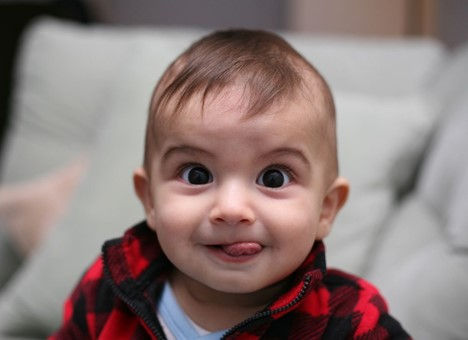
Eight-month-old infant, Wikimedia Commons
Where Science Meets the Book of Mormon: Come Follow Me Lesson: October 14-20; 3 Nephi 20-26
We are told in 3 Nephi 26: 14, 16, “And it came to pass that he did teach and minister unto the children of the multitude of whom hath been spoken, and he did loose their tongues, and they did speak unto their fathers great and marvelous things, even greater than he had revealed unto the people; and he loosed their tongues that they could utter. Behold, it came to pass on the morrow that the multitude gathered themselves together, and they both saw and heard these children; yea, even babes did open their mouths and utter marvelous things; and the things which they did utter were forbidden that there should not any man write them.”
I have always been intrigued by two phrases out of that scripture: “he did loose their tongues” (verse 14) and “even babes did open their mouths and utter marvelous things” (verse 16). It seems obvious from those verses that babies who were typically too young to talk, did talk and spoke of “marvelous things” — perhaps their memories from the pre-mortal life, which they normally would have forgotten by the time they learned to talk under normal circumstances.
I cannot find that any of our Church leaders have speculated about this issue. That is probably because of council such as that given by Elder Boyd K. Packer in 1971, “There are some things just too sacred to discuss. We know that as it relates to the temples. In our temples, sacred ordinances are performed; sacred experiences are enjoyed. And yet we do not, because of the nature of them, discuss them outside those sacred walls.”1 Even in the current Come Follow Me lesson, those phrases in 3 Nephi 26 are not even mentioned.
Therefore, I will not speculate about what the “babes” said, but from an anatomical and developmental perspective, perhaps how they said anything. First, we have no idea how old the “babes” were who spoke.
In 2011, Lillian May et al. asked the question: how does the newborn brain respond to language? The examined brain activity in 0-3 day-old infants and found, “Our results indicate a bilateral effect of language familiarity on neonates’ brain response to language. Differential brain activation was seen when neonates listened to forward Tagalog (unfamiliar language) as compared to other types of language stimuli. We interpret these results as evidence that the prenatal experience with the native language gained in utero influences how the newborn brain responds to language across brain regions sensitive to speech processing.”2
Mariko Uchida-Ota et al. found that such development was most enhanced by a mother’s speech. “We found that when hearing their mothers’ speech, functional connectivity was enhanced in both the neonatal left and right frontotemporal networks.”3
Joshua Hartshorne asked the question, “Why Don't Babies Talk like Adults?” He then attempted to answer that question: “First, the ‘mental developmental hypothesis’ states that one-year-olds speak in baby talk because their immature brains can’t handle adult speech…second, the ‘stages-of-language hypothesis,’ states that the stages of progress in child speech are necessary stages in language development...There’s evidence, for instance, that children don’t usually begin speaking in two-word sentences until after they’ve learned a certain number of words. Until they’ve crossed that linguistic threshold, the word-combination process doesn’t kick in.”4
Hartshorne concluded, “This finding—that having more mature brains did not help the adoptees avoid the toddler-talk stage—suggests that babies speak in baby talk not because they have baby brains, but because they only just got started learning and need time to accrue sufficient vocabulary to be able to expand their conversations. Before long, the one-word stage will give way to the two-word stage, and so on. Learning how to chat like an adult is a gradual process.”5
Paradoxically, although researchers “…may have explained why there are no talking babies—a prospect so absurd it makes us laugh if we see it in commercials or movies—we still need to explain how babies become eloquent adults.”6
There are also a bunch of structural, anatomical issues with very young babies talking. Babies’ mandibles are very small, their tongues are quite large compared to their mouth size, their palates are “U” shaped and rather soft, and they have no teeth. All of these anatomical features mechanically interfere with speech production.
Wake et al. examined “precocious talking” in children at one and two years of age and concluded, “Overall…it appears that precocity in early vocabulary development is not strongly influenced by the variables examined...”7 In other words, even though we are aware of precocious talking among children aged one to two, we don’t know why the phenomenon occurs.
If the “babes” in 3 Nephi 26: 14, 16 were in the age range of one to two years, they already had the anatomical features necessary for speech and perhaps also had the neurological development necessary. Christ and the spirit seems to have unlocked the as yet unknown parameters of speech and allowed more that only rare “babes” to speak.
Trent Dee Stephens, PhD
References
1. Packer, Boyd K., Conference Report, Apr. 1971, 123; or Ensign, June 1971, 87
2. May L, Byers-Heinlein K, Gervain J, Werker JF. Language and the newborn brain: does prenatal language experience shape the neonate neural response to speech? Front Psychol, 2:222, 2011
3. Mariko Uchida-Ota, Takeshi Arimitsu, Daisuke Tsuzuki, Ippeita Dan, Kazushige Ikeda, Takao Takahashi, Yasuyo Minagawa, Maternal speech shapes the cerebral frontotemporal network in neonates: A hemodynamic functional connectivity study, Developmental Cognitive Neuroscience, 39:100701, 2019
4. Hartshorne, Joshua, Why Don't Babies Talk like Adults? Scientific American, February 3, 2009
5. Ibid
6. Ibid
7. Skeat J, Wake M, Reilly S, et al. Predictors of early precocious talking: A prospective population study. Journal of Child Language, 37:1109-1121, 2010
Comments